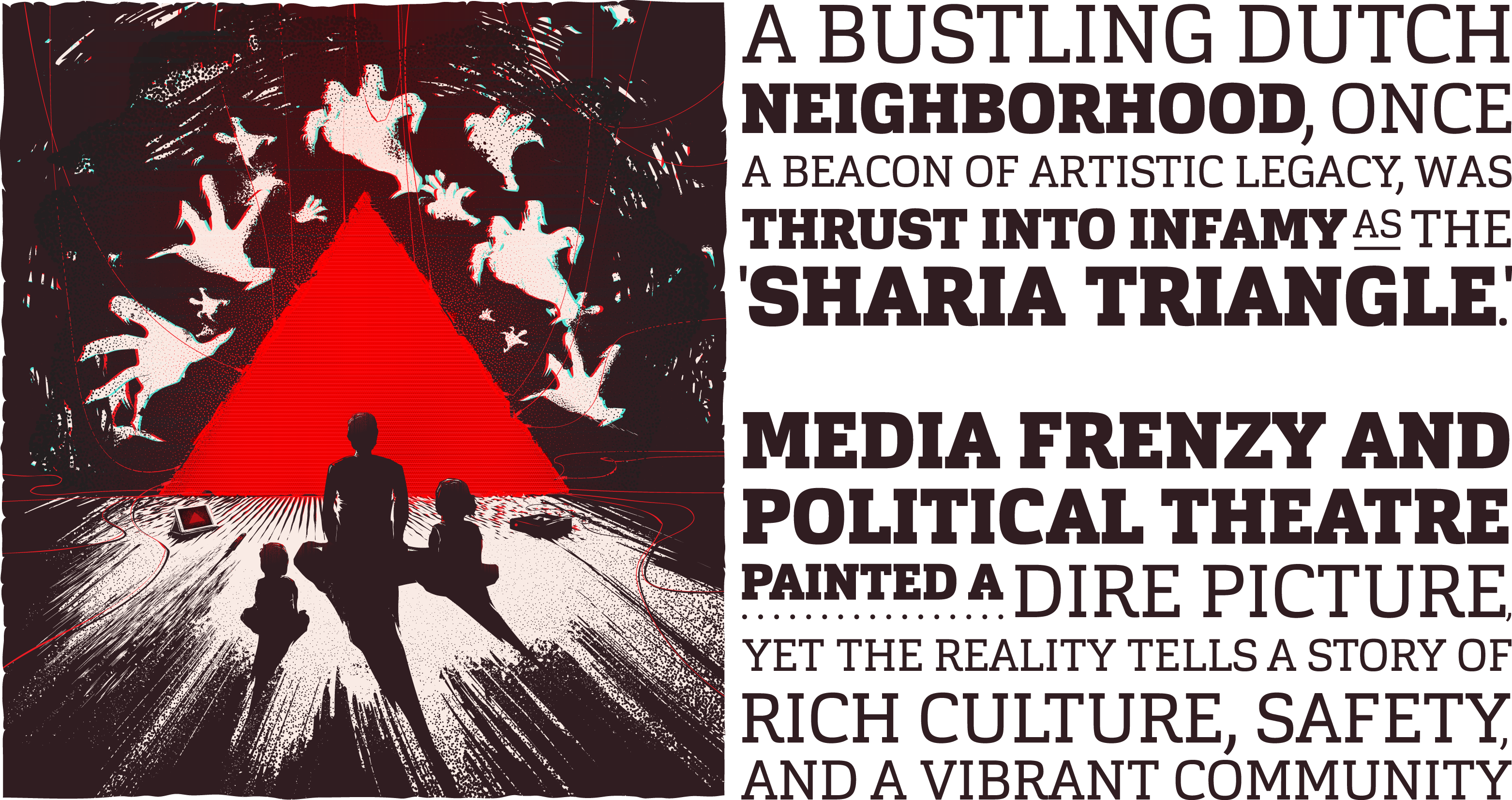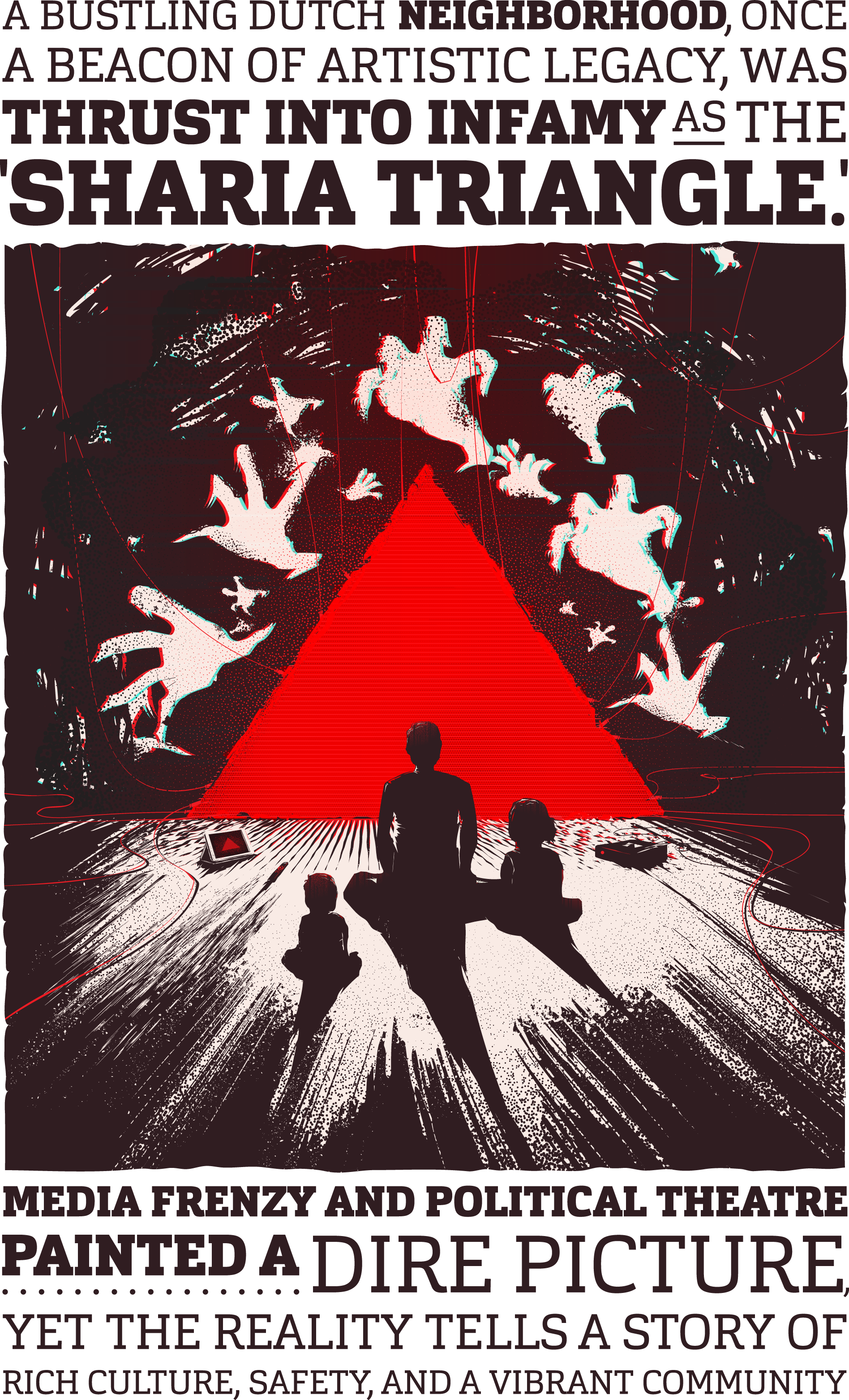
"The story of a little girl, Jihad, facing discrimination because of the name her parents gave her.
Pierce the veil--Unlock the truth--Racism, Nationalism, & Islamophobia, examined through the unbiased lens of scientific inquiry."



In the heart of The Hague, Netherlands, lies the neighborhood of Schilderswijk. Known in translation as “The painters’ neighborhood,” it was once a celebrated haven for artists and craftsmen. Now, however, it finds itself entangled in harmful labels that conceal its true colors.
I’ve known Schilderswijk my entire life. It’s a safe and creative community, full of vitality and cultural richness. But for those unfamiliar with its streets, sensational media coverage has reduced it to a simplistic and inaccurate term: The “Sharia Triangle.” This label has fostered an image of Schilderswijk as a hotbed of extremism.
Schilderswijk’s reputation as the “Sharia Triangle” didn’t emerge overnight. As a resident, I’ve witnessed firsthand the powerful forces of social pressures and media narratives that have allowed misunderstandings to thrive, casting a vibrant community into a role it never sought or deserved. This damaging reputation has been allowed to fester for far too long. Join me now as we unravel a web of scandal that reached the highest levels of Dutch journalism, unmasking the misconceptions that have twisted the truth.
In the complex story surrounding Schilderswijk, the As-Sunnah mosque found itself at the crossroads of controversy. This chapter began when its former Imam, Fawaz, issued a supplication to God against notable individuals like Ayaan Hirschi Ali and Theo van Gogh. The plea sent shockwaves through the nation, leading to urgent discussions among politicians in the “Tweede Kamer,” the Dutch House of Representatives. These discussions were heavily influenced and shaped by the media’s coverage itself. This incident later also contributed to the revoking of Fawaz’s license to serve as an Imam. (…hate imams?)
Having mentioned Hirschi Ali, it’s worth delving into her circumstances. Originally an asylum seeker from Somalia, she turned into a prominent critic of Islam who later became ensnared in a scandal of her own making. The revelation that she had fabricated aspects of her personal story not only led to her expulsion from her political party but also cast a long shadow over her credibility. Such manipulation of the truth begs the question: How can we trust the narrative when key figures weave their own deceptions? It also exposes a pattern where the truth about Islam and Muslim communities has been distorted for personal or political ends. It’s a pattern that perhaps inspired others, chief among them none other than Ramesar, the unscrupulous journalist more concerned with creating stories designed to shock the nation than reporting the truth.
A key figure in the parallel tale of deception we’ll soon uncover, this journalist was instrumental in shaping Schilderswijk’s image. The whispers of the media amplified into headlines, giving birth to the infamous “Sharia Triangle.” His sensational claims shaped the nation’s perception, planting seeds for a scandal yet to unfold. Brace yourself, as we are about to delve into lies and deceit so outrageous, its audacity is hard to believe.
The whispers and headlines weren’t merely confined to print; they had caught the eye of one of the Netherlands’ most polarizing figures. Geert Wilders, the infamous leader of the right-wing extremist party PVV, seemed eager to inspect the sensationalized claims for himself. His grandiose visit to Schilderswijk was as much theater as it was a political statement. Surrounded by bodyguards and followed by a throng of media, Wilders braved the neighborhood, facing dragons of his own imagining. This theatrical display turned the community into a temporary battleground for ideology, where the lines between myth and reality blurred.
While his appearance might have satisfied his political aims, it did nothing to shed light on the reality of the community. Instead, it perpetuated stereotypes and deepened the divide, all based on fabrications that were later revealed to be baseless. This neighborhood’s story is not just a localized tale; it’s reflective of a more widespread problem.
In 2014, Dutch newspaper Trouw was faced with an embarrassing revelation: One of their reporters, Perdiep Ramesar, was accused of fabricating stories. The tales he’d spun about Schilderswijk, filled with ominous warnings and stark portrayals, were called into question.
Trouw initially played innocent, professing to be oblivious to the fact that Ramesar hadn’t used legitimate sources. They claimed ignorance to the fabrication, painting it as an isolated incident, a mere oversight in the rigorous world of journalism.
The reader might be forgiven for thinking this was a singular lapse in judgment—a one-time error. But as the investigation unfolded, the scale of the deception became clear.
It wasn’t one article.
It wasn’t two.
It was one hundred and twenty-six articles.
One hundred and twenty-six separate instances where Ramesar’s stories had been published without verification; more than a hundred times where Trouw had failed to see—or chosen to ignore—the glaring falsehoods. The lies ranged from the sensational, such as claims of “Sharia police” patrolling the streets, to subtle manipulations of facts and figures, all painting Schilderswijk in a sinister light.
The ridiculousness of the situation only grew as more details emerged. How could such a massive oversight occur in one of the nation’s respected newspapers? Was it mere negligence, or was there something more at play? The removal of the articles and firing Ramesar were mere formalities in the face of a scandal that went to the core of journalistic integrity.
These are not merely exaggerations or manipulations; they are outright fabrications—stories spun from thin air, bearing no resemblance to the truth. Let’s explore a few of these examples:
1. The “Sharia Police”
Packs of “Sharia police” patrol Schilderswijk with their bloodstained batons, ruthlessly attacking the innocent for inappropriate dress, listening to music, or even letting the dogs out, and leaving their victims broken and bleeding beneath the iron fist of Islamic law—or so Ramesar claimed. This was his most sensational fabrication. Striking as these images were, local authorities confirmed they were complete fabrications; no such patrols or punishments ever existed.
2. The “No-Go Zone”
Another claim was that parts of Schilderswijk had become “no-go zones,” areas so overrun by extremists that even the police feared to tread there. Again, this was pure fiction. Law enforcement and community leaders uniformly refuted these allegations, yet the myth persisted.
3. The “Radical Mosque”
Corrupt imams preach hate and violence on a daily basis, inciting brutality and terrorist action in even the meekest of their followers, and turning Islamic places of worship into breeding grounds for cruelty and radicalism. Such was Ramesar’s portrayal of local mosques, especially the As-Sunnah mosque—a portrayal steeped in stereotypes and false narratives. Investigations by independent journalists, community leaders, and even government monitoring of mosques found no evidence of such teachings.
4. The Discrimination of Blond Hair
Shun those born with blond hair! For they are the devils’ spawn, deserving only to be singled out and discriminated against in Schilderswijk. Or so Ramesar would have us believe, as he went out of his way to paint them as targets of scorn and exclusion. This ludicrous claim overlooks the rich diversity of hair colors among residents, including those of Moroccan and Turkish descent—the two largest ethnic groups—many of whom have blond hair. A simple stroll through Schilderswijk reveals a celebration of diversity and exposes Ramesar’s willingness to exploit stereotypes.
Each of these fabrications adds to a distorted portrait of Schilderswijk, a caricature drawn not from observation but from prejudice and sensationalism. They are ridiculous not just for their audacity but for the ease with which they were accepted and disseminated.
But what do these lies tell us about the society that believed them? What do they reveal about the media landscape that allowed them to flourish? And most importantly, what do they say about our responsibility as consumers of news, as citizens, as neighbors?
As we unravel the web of these fabrications, we discover they are not mere lies about a neighborhood but a disturbing testament to how easily a religion and place can be demonized. What further amplifies the disgrace is Trouw’s inaction; the respected newspaper never took steps to rectify or correct any of the lies. The threads of deceit weave through politics, media, and our own perceptions, challenging us to look beyond sensationalism and stereotypes and seek the truth in a world where it’s all too easily obscured.
"The story of a little girl, Jihad, facing discrimination because of the name her parents gave her.
Pierce the veil--Unlock the truth--Racism, Nationalism, & Islamophobia, examined through the unbiased lens of scientific inquiry."





